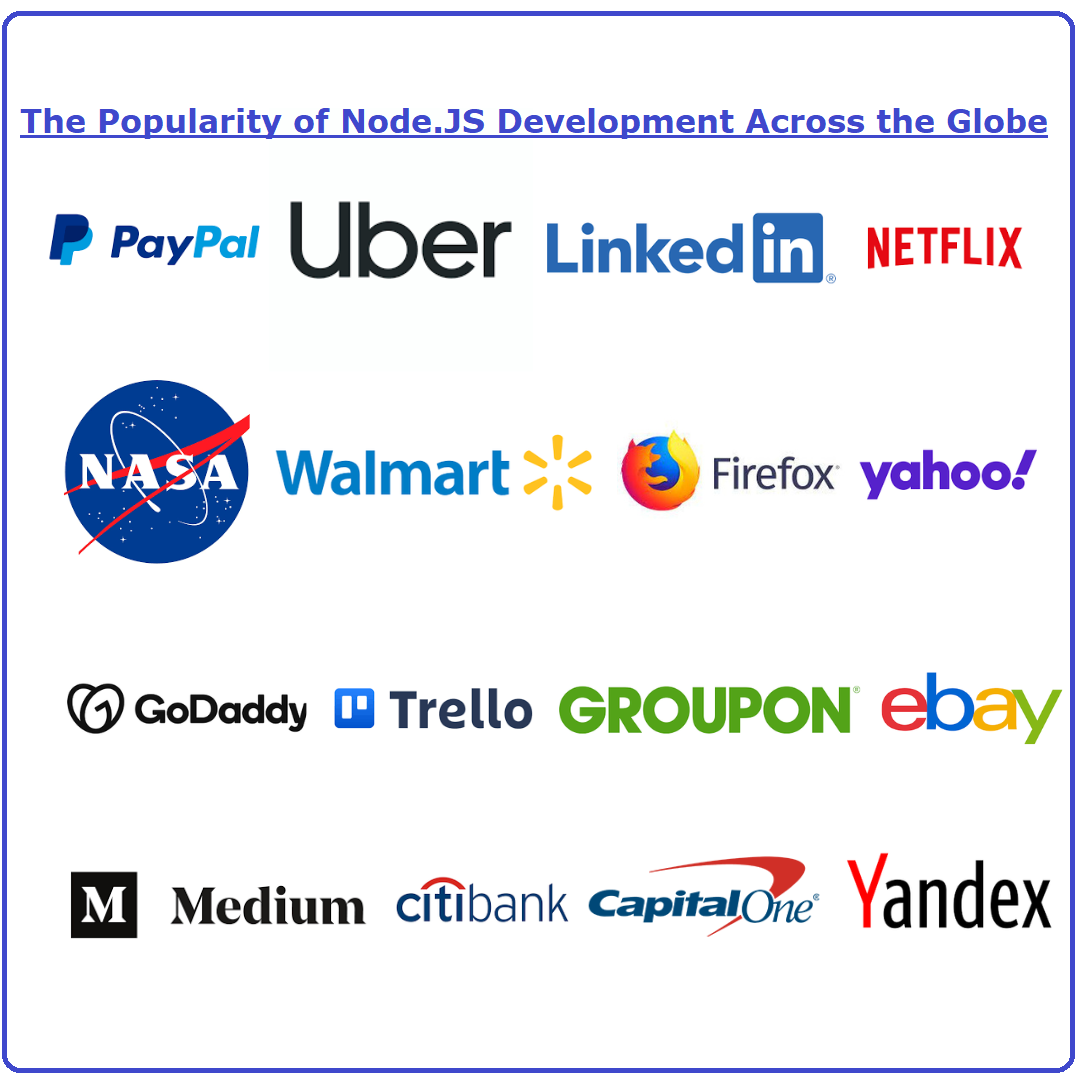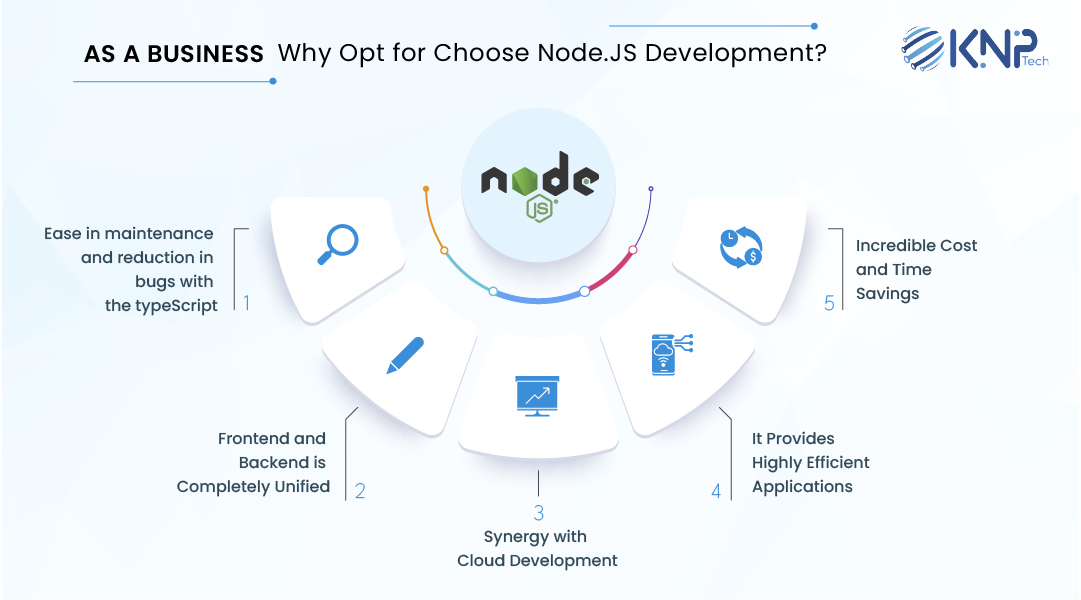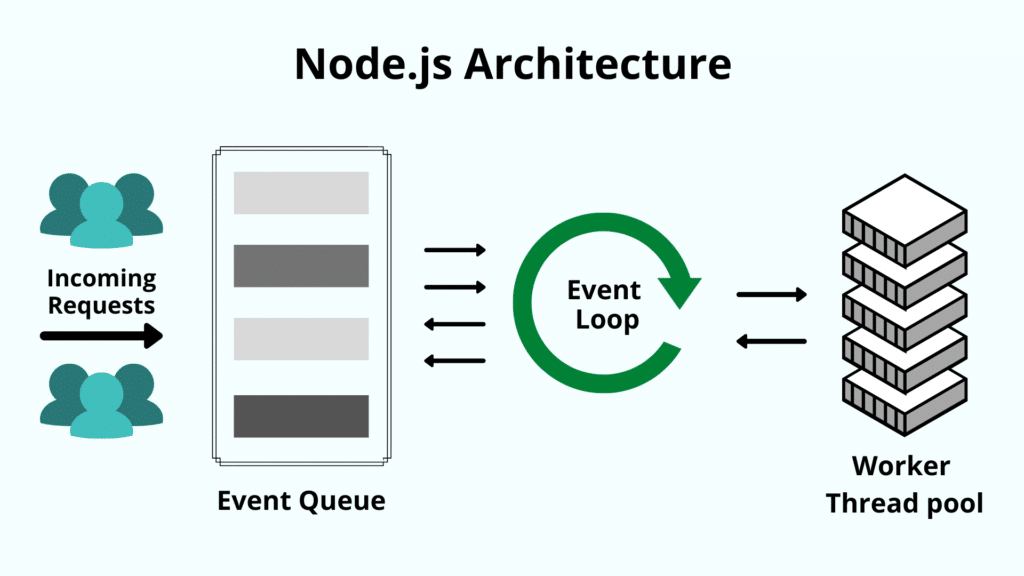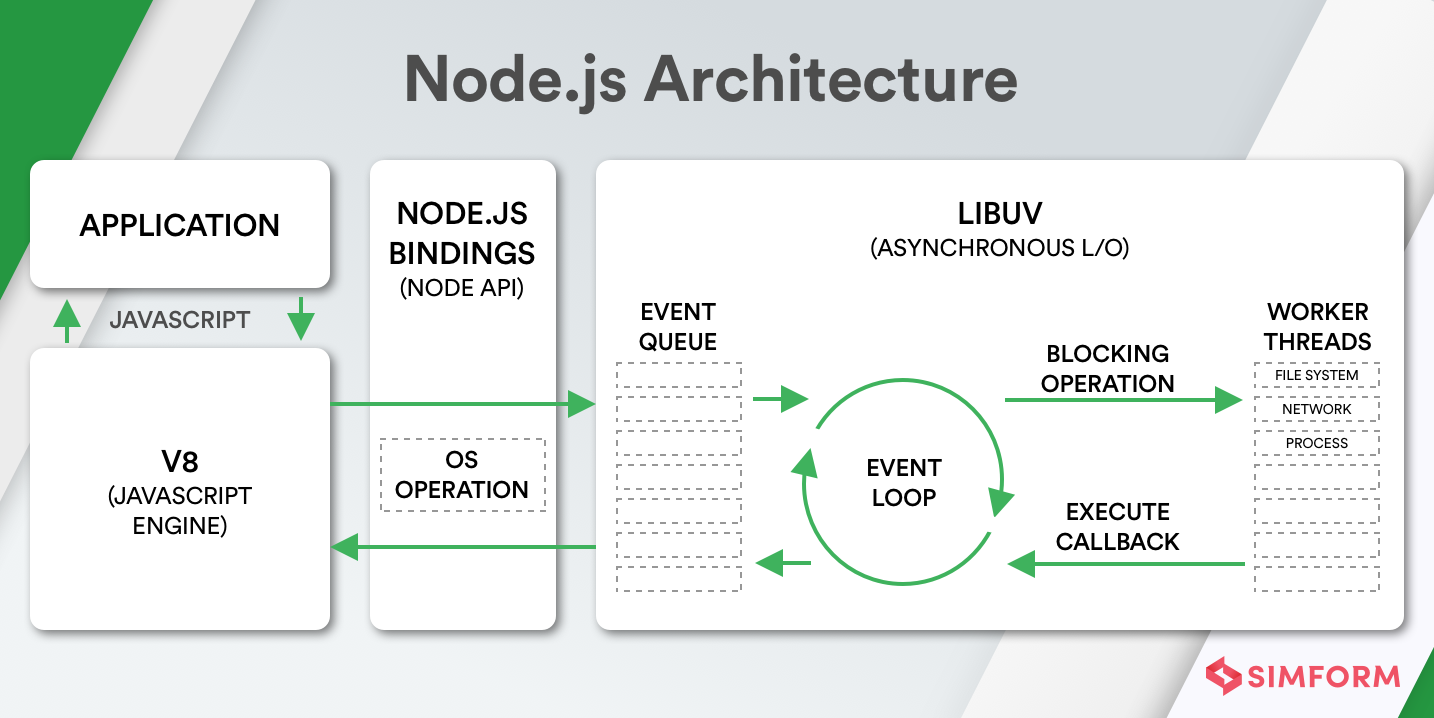Full Stack Web and Mobile Apps Development Company in India
What is Node.JS Development: The Ultimate Guide

Author
Priyank Panchal,
October 26, 2023
Are you looking to develop an application for your business? If the answer is yes, then you might know the importance of selecting the right tools, languages, platforms, and development partners.
And, if you are in a 50-50 situation as to what to select as frontend technology, backend technology, or what is Node.JS, why invest in Node.JS development – This is the page you need to scroll through.
From what is Node.JS to why to use it and what is the market scenario of it? We have got everything covered. So, here is our Node.JS complete guide. But let’s begin with what is Node.JS development.
What is Node.JS Development?
Talking in simpler terms – Node.JS is a JavaScript Runtime Environment that is also a cross-platform and open-source framework that allows web applications to be executed independently of the client’s browser.
Ryan Dahl was the man who invented it back in 2009, and currently, they have released a 15.14 version as per their official website data.
The Popularity of Node.JS Development Across the Globe
As of 2023, Node.js has become the most used web framework among software developers worldwide, overtaking React.js. According to a survey, around 42.7 percent of respondents reported using Node.js, while 40.6 percent used React.js.
Is that enough to justify the trend of Node.JS development? If not, we have another stat.
Well, for your information, 98% of Fortune 500 companies use Node.JS. Organizations like Capital One, Intel, PayPal, Netflix, GoDaddy, Node Source, npm, and Uber use Node.js to meet their innovation needs.

Moving ahead in the Node.JS complete guide – let’s see some of the core features of NodeJS.

Best Seven Features of NodeJS

Thanks to this, you’ll have a deeper understanding of Node.js and be able to determine that Node.JS development, is the best choice for your software development projects.
1.Event-Driven Programming
Programming that is “event-driven” provides a prompt reaction to actions taken by the user, such as mouse clicks or critical inputs. This feature is intended to detect actions after they have occurred to achieve a more responsive and intuitive UX and to give more flexibility to the app.
2.Microservices
Microservices are small, independent modules that are used in conjunction with one another to create a larger application. By doing so, they ensure that distinct parts of a program may be updated, changed, and maintained independently from one another.
3.Node Package Manager
Node Package Manager (NPM) Also known as NPM, the note package manager is an in-built support that does the job of package management. It has hundreds of thousands of downloadable libraries that may be tailored to meet the requirements of a user’s tastes and needs.
The Node.js community is given a significant boost thanks to NPM, which is primarily recognized as the world’s biggest software registry. Users don’t have to pay anything to access the registry, and it continues to grow on a daily basis.
4.Non-blocking I/O
This function was designed to circumvent the problem posed by the synchronous thread, also referred to as the distinct threads. This is the circumstance in which a new thread is initiated for each request, halting the whole operation.
Node.js makes it possible to operate with individual threads one at a time, in contrast to the various settings that often assist web servers in starting individual threads.
5.Libuv
Libuv is a particular cross-platform C library that was primarily developed for settings that use Node.js. It enables the continuous processing of single threads utilizing a method that is known as an event loop.
When you use these features, you can, without a doubt, construct a robust app that has a high performance, automates time-consuming chores, assures robust routing, and offers top-notch test coverage. You can do all of these things by using these features and modules.
6.Quick Execution Time of the Code
NodeJs uses the V8 JavaScript runtime engine, which Google Chrome also uses. This results in a quick execution time for code. The hub provides a wrapper for the JavaScript, which makes the runtime motor more efficient. Because of this, the preposition process of requests also gets more efficient inside NodeJs.
7.Compatibility Across Several Operating Systems
NodeJs is compatible with various operating systems, including Windows, LINUX, MacOS, and even specific mobile devices. It is possible to combine it with any applicable package to produce an execution that is self-sufficient.
As A Business, Why Opt for Choose Node.JS Development?

When the topic is Node.JS development, you need to choose it for many reasons. Here, we have described some of the best reasons. Remember – Every business has its own needs and reason to select Node.JS.
1.Ease in Maintenance and Reduction in Bugs with The TypeScript
Using TypeScript in Node.js projects doesn’t guarantee a bug experience. It definitely improves code clarity and maintainability. The presence of typing enhances the quality and readability of the code, making collaboration among teams easier.
Furthermore, it allows developers to simplify the debugging process and allows to slove issues quickly.
2.Frontend and Backend is Completely Unified
Choosing Node.JS development simplifies the process by allowing JavaScript to be utilized for both backend and frontend coding. While this consistency may not necessarily expedite development, it does facilitate a smoother learning curve for developers.
Additionally, it promotes project management as teams can collaborate using a single language across the entire stack. It’s a win-win for all.
3.Synergy with Cloud Development
Node.js fits cloud environments as it seamlessly integrates and deploys across cloud services. This allows businesses to quickly scale and improve performance, adapting to market demands and growing without restrictions.
The natural compatibility between Node.js and the cloud also simplifies the setup of DevOps pipelines, making development cycles more efficient.
4.It Provides Highly Efficient Applications
Organizations that use Node.JS development apps are often praised for their effective use of resources and rapid execution times, particularly when compared to server-side languages.
This benefit comes from Node.JS’s ability to handle many requests efficiently while efficiently using system resources.
5.Incredible Cost and Time Savings
Last but not least, in this Node.JS guide, The Node.js community has various libraries and frameworks that are open source and ready to use. And that enhances the speed of development and decreases expenses.
In addition to this, when time reduces, parallel costs reduce for Node.JS development.
Does Node.js Count as A Programming Language?
Absolutely not.
To put it simply, Node.js is not a language. To be more precise, it’s a runtime environment used to execute JavaScript outside of a web browser.
Neither is Node.js a framework (a foundation upon which to build other software). So, Node.js is not a language or framework but rather an environment where languages and frameworks may be developed and run.
To What End (Front or Back) Does Node.JS Serve?
Many developers widely believe that Node.js is mainly utilized for server creation. However, it is essential to note that Node.js is equally practical and applicable in both the end and backend development of a website.
The event-driven, non-blocking nature of Node.js frameworks is a big draw for developers looking to create a versatile and scalable backend. On the other hand, frontend developers will experience these same advantages in their work thanks to Node.js.
Let’s examine why, as a business, you can go for Node.JS development irrespective of the backend or the frontend:
· With the aid of frameworks like Express.js and Meteor.js, JavaScript is used to develop both the back and frontend of a website.
· Express.js, a backend framework for Node.js, is used by specific well-known stacks like MERN. The front end and the back end may share several components.
· Developer efficiency and productivity may benefit from less time spent jumping between different languages and contexts.
· Using JavaScript for both the backend and the frontend allows you to use the numerous shared tools between the two.
· An active online community may significantly shorten the time it takes to complete a development cycle.
· If you’re having trouble solving a problem, you should check Stack Overflow to see whether anybody else has encountered the same issue. This community is beneficial to Node.js since it is very involved with the popular runtime and its packages.
What is Node.JS Architecture & How Does it Work?
The “Single Threaded Event Loop” design is what Node.js uses to manage several clients all at once. To fully grasp the distinctions between this runtime and others, it is essential to have an understanding of how programming languages, like Java, handle the management of threaded concurrent clients.
In a threaded request response concept, multiple clients will each send a request, and the server will handle each request separately before providing the response. However, to handle calls, multiple threads are employed.


Future of Node.JS

In the world of runtime environments, Node.js development has gained widespread acclaim for its versatility in crafting fully operational applications.
Consequently, we anticipate the emergence of several notable NodeJS development trends around 2023-24, some of which are poised to impact the application development landscape substantially. Here, we explore the key trends in Node.js development:
1.The prominence of GraphQL
According to recent trends, Node.js development has been focusing on GraphQL, which is a flexible technology that provides users with access to Facebook APIs and the ability to modify data. GraphQL’s popularity is due to its adaptability across various data sources and ease of integration into different platforms, with examples of placeholder structures.
2.The Internet of Things (IoT)
Node.js is a JavaScript platform that proves to be extremely beneficial for developing IoT applications. Numerous prominent IoT companies are actively seeking out specialists in Node.js to harness its potential when it comes to microservices, real-time functionalities, and data-centric strategies.
3.The Rise of Microservices
Enterprise-grade applications are equipped with features and functionalities that exceed those found in types of software. When embarking on the development of an enterprise-level project, the utilization of microservices becomes crucial. These microservices offer a range of benefits, such as improved performance, simplified debugging, and support for server infrastructure. By utilizing Node.js, you can seamlessly. Take advantage of microservices in your projects.
4.The Rise of Serverless Architecture
Serverless technology allows developers to concentrate on building applications of dealing with infrastructure maintenance. The advantages of serverless architecture include saving costs in deploying and enjoying greater flexibility.
5.The Ascendance of MEAN and MERN Stacks
MEAN (which includes MongoDB, Express, Angular, and Node.js) and MERN (which includes MongoDB, Express, React, and Node.js) have become widely recognized as popular JavaScript stacks that are available and open source. These stacks are commonly used for developing websites and applications.
Advantages of Node.JS Development
Here are the Node.JS development Advantages:
Low Learning Curve for JavaScript Developers:
Node.js offers a smooth transition for developers already well-versed in JavaScript, minimizing the learning curve.
Runtime Environment with Module Caching:
Node.js boasts a runtime environment that efficiently caches modules, enhancing performance and speeding up development.
Enhanced I/O Handling with Event-Driven Architecture:
Node.js leverages an event-driven architecture, resulting in superior input/output (I/O) request handling, which contributes to faster and more responsive applications.
Unified Codebase for Server and Client:
Node.js enables developers to use the same code for both server-side and client-side, simplifying the deployment of web applications and reducing redundancy.
The Dominance of NPM:
Node.js enjoys the support of the largest package manager in the software world, NPM, offering a vast repository of modules and packages for developers.
Best Practices of Node.JS Development
Now that after a brief understanding of Architecture, in this Node.JS guide – we will look at some of the best practices suggested by our experts while opting for Node.JS development.
1. Implement Caching
To store the modules in memory, you can use Node JS’s built-in module caching mechanism. This approach helps reduce the server’s workload and improves the time it takes to respond. Consider using in-memory caching solutions such as Memcached and Redis.
By leveraging the Node.js caching method, you can boost your application speed, optimize resource usage, ensure consistency, simplify dependency management, and even support hot module replacement.
2. Use Asynchronous Programming
There are reasons why Node.js development is highly valued, and one of them is its programming methodology. When working on web projects for businesses, developers using Node.js can improve efficiency and scalability by writing code that handles I/O operations and other resource-intensive tasks in a manner.
This can be accomplished through the utilization of callback functions, promises, and the async/await syntax. By adopting this approach, corporate applications can effectively meet the real-time demands of their user base without sacrificing performance or effectiveness.
3. Use Third-party Modules with Care
Node JS provides a variety of coding modules that can greatly aid developers in building app functionalities. However, developers must verify the dependability of these modules before incorporating them into their applications. This can be accomplished by evaluating the module’s documentation, maintainers, and community support.
4. Keep Your Code Modular
Node JS supports the development of microservices, which allows for creating code by breaking down the program into individually deployable components.
This approach dramatically aids in building applications as it streamlines tasks such as working with updating, maintaining, and managing the codebase. To enhance code modularity, you can leverage existing NPM packages. Even develop your own.
5. Use a Robust Error-handling Strategy
Dealing with errors in Node.js applications is extremely important to ensure performance and assist with debugging.
It is advisable to adopt a structured approach where errors are diligently documented and monitored at all levels of the program. Node applications can employ try-catch blocks or error middleware to identify and manage failures efficiently.
6. Use a Task Runner to Automate Repeat Workflows
Automating steps in the application development process will able to save you a lot of time along you and your team can have an increase in productivity. When it comes to automating tasks in Node.js applications, popular choices are Grunt and Gulp, which serve as task runners. For executing tests, utilizing a Node automated testing framework such as Mocha, Jest, or Chai is essential.
7. Implement Environment Variables
Utilize and implement environment variables to securely store data from the application’s source code, like database credentials, API keys, and other configuration settings in a location. By keeping values separate, we can ensure the privacy of information, enhance configuration management, simplify the handling of environment-specific settings, enable flexible deployment options, and maintain compliance adherence effectively.
KNP Tech as Your Trusted Node.JS Development Partner
So, that’s it – we are coming towards the end of Node.JS, the complete guide. Finding an agency for Node.JS development is crucial to ensure your project receives the expertise and achieves the desired results. Depending on your specific needs, budget, goals, and timelines, some companies could be your chosen partner for outsourced Node.js enterprise app development.
KNP Tech is a force in the software development world. Our team of creative engineers specializing in mobile and web app development is dedicated to delivering exceptional results for clients like yourself. Our team comprises designers, developers, testers, and strategists. Each unit has its project coordinator following industry practices.
As your technology partner, we strive to stay ahead of industry trends to ensure benefits for our clients. At KNP Tech, we adhere to development methodologies when creating web and mobile apps, offering top-notch conceptualization through the deployment cycle.
FAQs
-
Question: 1 What precisely defines Node.js, and how does it set itself apart from traditional server-side technologies?
Answer: Node.js serves as a runtime environment that uses the V8 JavaScript engine to execute JavaScript code on the server side. What sets it apart is its blocking event-driven architecture, which offers scalability and efficiency in managing multiple connections concurrently. A departure from traditional server-side approaches.
- Question: 2 In what practical scenarios does Node.js development find its primary applications?
Answer: Node.js showcases its versatility in contexts, including building microservices architecture, real-time applications like chat systems and online gaming, and server-side APIs. Its lightweight and efficient nature allows it to meet development demands effectively.
- Question: 3 How does Node.js navigate through asynchronous operations, and what significance does its event-driven model hold?
Answer: To handle tasks effectively, Node.js adopts an event-driven blocking paradigm. It enhances application performance and responsiveness by utilizing callback functions and event emitters that enable it to handle I/O operations without waiting for them to complete.
- Question: 4 What merits and challenges come with the adoption of Node.js in a development project?
Answer: Whether your project is tiny or large-scale, Node.js can handle it with ease. It is very efficient at managing many concurrent connections due to its event-driven design and simplified architecture. The scalability and efficiency of Node.js make it a popular choice among corporations for developing strong apps.
